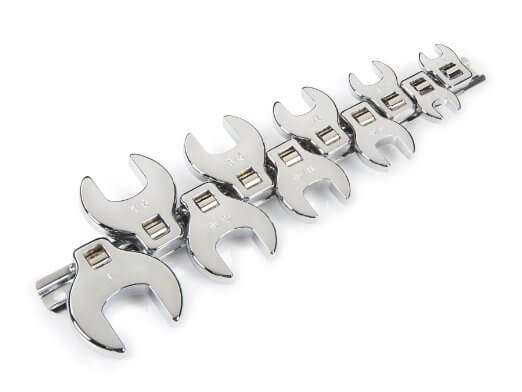Why you need a crowfoot wrench set
Use a CrowFoot wrench set when working in tight spaces
The crowfoot wrench has that weird name because it resembles a crow’s foot. It is a specialized tool cherished by mechanics, plumbers, and DIY enthusiasts for its ability to access nuts and bolts in tight spaces where conventional tools don’t fit. However, understanding its proper usage is essential to harnessing its full potential. Let’s delve into the fundamentals of using a crowfoot wrench set effectively.
What is a Crowfoot Wrench?
A crowfoot wrench is designed to tighten or loosen
fasteners in cramped or awkward locations, providing superior torque to standard wrenches. Its distinctive design features a short, stout handle and a head shaped like a crow’s foot, available in various sizes to accommodate different nut and bolt dimensions.
To maximize leverage, a crowfoot wrench is used with an extension and a ratchet.
Types of Crowfoot Wrenches
Crowfoot wrenches come in several configurations tailored for different tasks:
- Flare Crowfoot Wrenches are ideal for automotive applications, especially fluid lines like brake hoses, where their flare-shaped head securely fits around fittings.
- Open-End Crowfoot Wrenches: Versatile and straightforward, these wrenches grip two sides of a fastener, making them popular for general mechanical and DIY tasks.
- Box-End Crowfoot Wrenches: Designed for tight or loose fasteners, these wrenches offer a secure grip and are available in both open-end and closed-circle configurations.
- Adjustable Crowfoot Wrenches: Often used in plumbing, these wrenches allow adjustment of jaw size to fit various pipe diameters, enhancing versatility.
- Ratcheting Crowfoot Wrenches: These wrenches feature a mechanism that allows continuous turning without repositioning, saving time and effort during tightening or loosening operations.
How to Use a Crowfoot Wrench
To effectively use a crowfoot wrench:
- Select the Right Ratchet: Ensure compatibility between your crowfoot wrench and ratchet by matching their square drives.
- Proper Alignment: Position the wrench correctly to avoid slipping. Hold it with the jaws facing the direction of the twist, ensuring the part of the jaw atop the fastener is closer to you.
- Attach to Ratchet: Insert the wrench’s square drive into the ratchet’s square drive to form a secure connection.
- Grip the Fastener: Fit the crowfoot wrench around the fastener, ensuring the jaws securely grip its sides. Maintain the handle at approximately 90 degrees for optimal visibility and maneuverability.
By following these steps, you harness the full potential of your crowfoot wrench, enhancing both efficiency and safety in your maintenance or repair tasks.

Crow foot wrench set (non-flare) design
© 2012 Rick Muscoplat
Posted on by Rick Muscoplat
